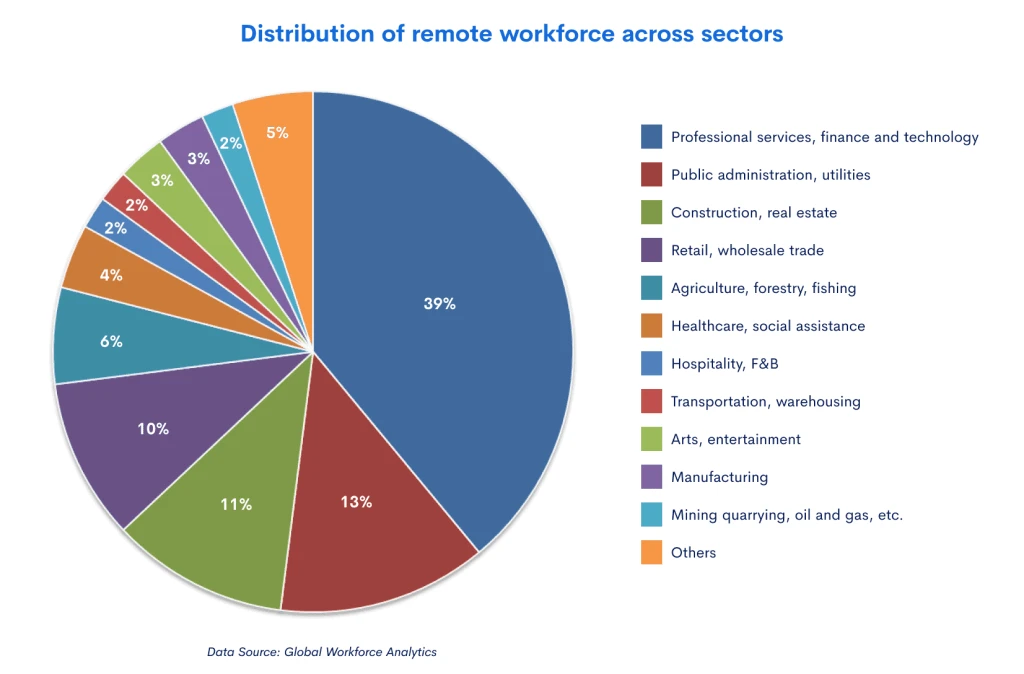1. The remote workforce is on the rise
It is the post-Covid era in 2021, and as I sit in an Airbnb, typing this article out from the foothills of the Himalayas, alongside a river, I can guarantee you one thing – the remote workforce is on the rise. As per a survey conducted by Upwork, it is estimated that 23% of the US workforce, i.e. about 36.2 million Americans would be working remotely by 2025. This is an 87% increase from pre-pandemic levels. Global Workplace Analytics estimates that 25-30% of the workforce will work from home for several days a week by the end of 2021.
1.1 Where is the remote workforce located?
While the world is moving towards a hybrid working model, the majority of remote jobs are concentrated in the professional services, finance, and technology sector. The chart below shows the percentage of people who work at home by industry.

While the majority of the workforce cannot work remotely, in the developed economies up to one-fourth of the workforce can be fully or partially remote. Further organizations are augmenting the full-time workforce with freelancers, or the “Digital Nomads”, which contribute by working completely remotely.

1.2 Understanding the remote workforce
The demographics, persona, and aspirations of the remote workers would dictate the kind of retention strategies the organizations would require.
A typical telecommuter is college-educated, 45 years old or older, and earns an annual salary of $58,000 while working for a company with more than 100 employees. 75% of employees who work from home earn over $65,000 per year, putting them in the upper 80th percentile of all employees–home or office-based.
The remote workforce is highly educated, values engaging work and seeks wellness, work schedule flexibility, autonomy as well as access to good learning opportunities.
2. Traditional vs. remote workforce retention techniques
As the makeup and aspirations of the workforce change with the rise in remote working trends, organizations need to relook at their talent management practices ensuring they can sufficiently engage and retain this emerging segment of the workforce.
Talent management, employee engagement methods, and hence retention models would vary across the workforce segments. Organizations need to build on the trends outlined below to drive initiatives and invest in digital platforms/technologies to engage and retain remote employees.

2.1 Onboarding and role clarity
Role definitions may start to fall apart during the disruption, leaving employees unsure of where to focus. Focus on what employees should be accomplishing.
“One of the top engagement drivers for employees is seeing their work contribute to company goals. Employees who feel confident about the importance of their job to the success of the organization feel less anxious about their job security.” (Source: Gartner)
Other than crafting and communicating clear role expectations, the hiring and onboarding process is also critical to ensure engagement for the remote workforce. Start with a robust pre-onboarding process, and have continued checkpoints over the first 2 weeks, and then at later stages to take continued feedback from the employees.
2.2 Performance and team engagement
2.2.1 Practice positive and ongoing performance feedback
Employees working fully remotely are nearly twice as likely to receive corrective feedback – which focuses on behavior that was not successful – most often. With remote employees, organizations need to ensure that feedback conversations are two-way, more open, evidence-based, and forward-looking. Further, the management of performance should not be hours-based, but outcome-based. Organizations can invest in technology to set and update goals and objectives related to desired outcomes and generate feedback on those objectives. For example, General Electric (GE) replaced a performance management system with a coaching app called PD@GE to provide real-time information and feedback to employees. Managers set up touchpoints throughout the year to build accountability and help employees develop professionally. Importantly, these types of technologies are not used to monitor employee presence, but to provide opportunities to share information and guide employees.
2.2.2 Cultivate trust and emphasize outcome over processes
Gartner analysis finds that two-fifths of remote employees want more self-directed work. (Source: Gartner) Managers must trust their employees and shift away from directing their work to coaching them to success. In the remote landscape, where many people are juggling work and family commitments in their own homes, enables employees to complete their work in ways that are easiest and most productive for them. Your 9 a.m. team meeting may have to go or you may have to forgo a lengthy approval process. Providing flexibility and focusing on output – empowers teams to complete their assignments in their own way, creates greater clarity in terms of what their exact role is, and helps retention by driving greater engagement levels.
2.2.3 Enable employees to build social and emotional connections
Collaboration, building team relationships, and including remote workers in the broader company culture all become more challenging when co-workers aren’t all in the same physical space. As per Gartner ReimagineHR Employee Survey, 41% of respondents don’t feel connected to colleagues when working remotely and 26% of employees feel isolated when they work remotely. Organizations need to identify this distress and leverage technological solutions and regular communication to help remote workers feel less isolated. To overcome remote worker isolation and barriers to teamwork, create virtual common spaces like message boards or intranets, allowing remote workers to interact with their colleagues and enabling the type of informal interaction they might have in an office. Strengthen the digital communication platforms further with regular on-site meetings.
2.3 Rewards and recognition
“During periods of disruption, employees’ desire for being recognized for their contribution increases by about 30%,” explains Gartner expert Brian Kropp. (Source: Gartner)
In a remote working setup, organizations need to assess what additional behavior they want to drive via recognition other than the traditional performance focus. They may choose to recognize employees for innovation and creativity, prioritizing health and safety, showing compassion and care, maintaining productivity, living company values, etc. – all of which are equally important in a remote or hybrid workplace setup.
Organizations need to focus on creating and leveraging digital platforms for recognizing employees. Additionally, they can provide benefits like health and well-being focused sessions, work from home equipment, spa care packages, etc.; have occasional deliveries like flowers, personalized thank you notes; arrange for special dining and deliveries, provide gift cards, etc. While providing these benefits, they just need to ensure enough transparency and social recognition within the teams for the employees.
Given the lack of visibility in a remote environment, managers also need to improve their monitoring techniques and relationships with direct reports. Use simple pulse surveys to ask specific questions or track output to collect data and find areas of recognition. By meeting with employees virtually and asking what barriers they have overcome, or ways peers have helped them, they can identify elements to recognize, thank and share the accomplishments of teams and their members.
2.4 Learning and skill development
In the past, L&D activities were considered optional and were often suspended or cut whenever there were downturns or significant business challenges. In contrast, now when the organizations are looking at longer-term remote work scenarios, L&D is achieving even greater focus. This is primarily driven by the recognition that knowledge work is more important than ever, and second, the need to keep employees engaged and invest in their continued development as they work remotely. To design deeper learning experiences for the remote workforce, organizations should aim for maximum flexibility in learning tools and processes. They need to aim at on-the-go byte-sized learning content, which is on-demand, rather than the traditional module-based learning packed over 1-3 full-day sessions. Incorporating real-work applications into learning processes and building elements of peer-to-peer learning would further strengthen employee development and engagement levels.
2.5 Enabling infrastructure
As the organizations build a hybrid workforce, they need to ensure employees are equipped with the right technological systems to ensure remote working and collaboration appropriately. It is important to both invest in the right infrastructure, and to also train the employees and encourage the appropriate use of such platforms.
Acknowledge that virtual communications are different — and won’t be perfect — but should still be professional and respectful of others. Be mindful that virtual communications may be less comfortable and effective for some, and coach employees on when and how to escalate ineffective virtual exchanges. For example, if you haven’t settled an issue in six emails, the conversation may need to be elevated to a virtual meeting to get closure.
2.6 Encourage innovation
With businesses sheltering in place amid high levels of uncertainty, managers and employees may understandably become more risk-averse. “There’s a natural hesitancy among employees during disruptive times to be afraid to try something new,” says Kropp. But it’s during such times that innovation and risk-taking become even more important for employee engagement and organizational success. The disengaging effect of constraints on innovation and risk-taking is particularly severe for high-potential (HIPO) employees, who tend to have a stronger desire for these types of opportunities. Even when the organization has constraints on new investments, managers can emphasize the need and provide opportunities for incremental innovation or process improvements. Provide opportunities to share successes and safety for potential failures. The confines of social distancing mean that when employees take a risk and succeed in improving their productivity, only a few connections can build on that success. Make an effort to highlight the value of employees’ continuing to scale their activities and ensure that any risks are worthwhile.
3. To summarize
Organizations need to prepare in advance to ensure they retain their remote workforce. The first step is to recognize and understand their workforce requirements and link them to the business strategy. The next step is to build an enabling ecosystem leveraging the technology appropriately and building appropriate talent policies, factoring in the fact that the digital nomads and flexi-commuters are very different from the traditional office goers. Communication and employee engagement is the key, and the team managers would play a key role in both driving these processes and managing and finally responsible for retaining the remote workforce. Finally, organizations should also be cognizant of the fact that their entire workforce is not remote. The future of work is hybrid, and as they focus on retaining the remote workforce, they would also need to invest in ways to engage the workforce which does continue to come to the office.
